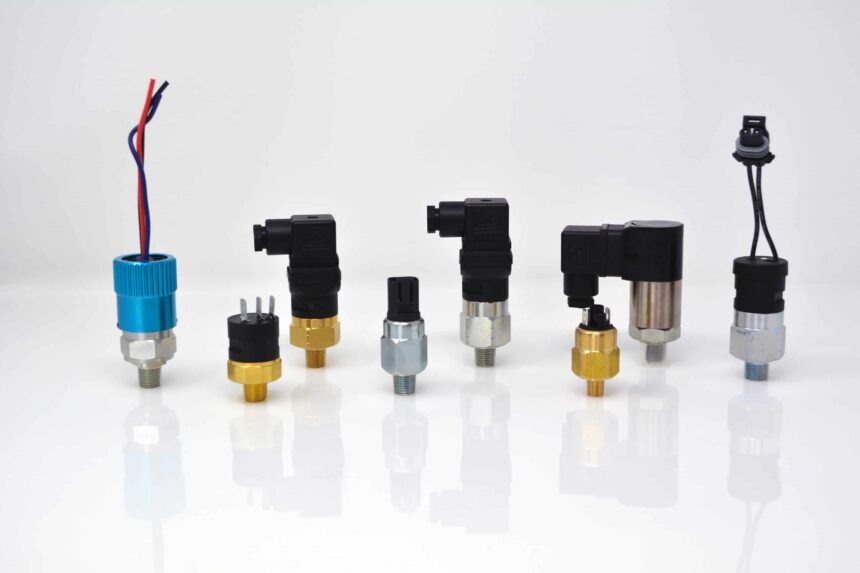Introduction to Pressure Switches
Pressure switches play a vital role in various industrial and commercial applications. These devices ensure that systems operate safely and efficiently by monitoring pressure levels and making adjustments as necessary. Whether you’re working with HVAC systems, hydraulic equipment, or water pumps, choosing the right pressure switch is crucial.
But with so many options available on the market, how do you determine which one best fits your needs? Understanding the different types of pressure switches, their features, and key factors for selection can make all the difference. This guide will walk you through everything you need to know about selecting a pressure switch tailored to your requirements.
Different Types of Pressure Switches
Pressure switches come in various types, each designed to meet specific needs. Understanding the differences can help you make an informed decision.
Mechanical pressure switches are the most common type. They use a physical mechanism, like a diaphragm or piston, to detect pressure changes. These devices are reliable and straightforward but may lack precision compared to their electronic counterparts.
On the other hand, electronic pressure switches offer advanced functionality. They utilize sensors and microprocessors for enhanced accuracy and quicker response times. This allows for more precise control in complex systems.
Choosing between mechanical and electronic options depends on your application requirements. Each has its strengths, catering to different industries and environments where reliability is key.
A. Mechanical Pressure Switches
Mechanical pressure switches are a staple in industrial applications. They operate using a physical mechanism that responds to changes in pressure. This can include diaphragm, piston, or bellows designs.
One key advantage of mechanical switches is their reliability. Without the need for complex electronics, they often withstand harsh environments better than their electronic counterparts.
These devices typically feature adjustable set points, allowing users to customize activation levels according to specific needs. Installation remains straightforward since they usually connect directly to the system being monitored.
However, while generally robust and cost-effective, mechanical switches may fall short in terms of precision compared to electronic options. Their response time can also be slower due to the moving parts involved.
Selecting a mechanical presure switch requires careful consideration of application requirements and environmental factors.
B. Electronic Pressure Switches
Electronic presure switches utilize advanced technology to offer precise control over pressure levels. Unlike their mechanical counterparts, they rely on electronic components, providing faster response times and enhanced accuracy.
These devices can be integrated into various systems for real-time monitoring. They often feature programmable settings, allowing users to customize activation points based on specific requirements. This adaptability makes them suitable for a wide range of applications.
One standout benefit is their ability to handle fluctuating conditions with ease. Electronic pressure switches are less susceptible to wear and tear since they don’t have moving parts that could fail over time.
Moreover, many models come equipped with digital displays for easy reading of pressure levels. This added functionality simplifies troubleshooting and maintenance tasks in complex systems. Electronic pressure switches represent the future of efficient pressure management across multiple industries.
Factors to Consider When Choosing a Pressure Switch
When selecting a pressure switch, the operating environment plays a crucial role. Consider factors like temperature extremes, humidity levels, and exposure to chemicals. These elements can directly impact the switch’s performance and longevity.
Next is accuracy and sensitivity. Depending on your application, you may need precise readings or broad tolerances. Assessing these specifications ensures that the pressure switch meets your requirements without compromising functionality.
Electrical ratings are another essential consideration. Make sure that the switch can handle voltage levels and current loads specific to your system. This helps prevent potential failures or hazards during operation.
Think about installation ease and maintenance needs. A user-friendly design saves time in setup and future adjustments while allowing smooth ongoing operations in various settings.
A. Operating Environment and Conditions
When selecting a presure switch, understanding the operating environment is crucial. Different settings can impact performance and longevity.
Consider factors like temperature, humidity, and exposure to chemicals. Extreme temperatures might affect the reliability of certain switches. For outdoor applications, ensure your device can withstand weather elements.
Vibration is another key aspect. Equipment in motion requires pressure switches designed to handle constant movement without failing.
Also think about installation location; tight spaces may limit access for maintenance or replacement.
Understanding these conditions helps you choose a presure switch that will perform reliably over time.
B. Accuracy and Sensitivity
When selecting a pressure switch, accuracy and sensitivity are key factors. An accurate pressure switch ensures that it activates at the correct set point. This precision is crucial in applications where even slight deviations can lead to significant issues.
Sensitivity refers to how responsive the switch is to changes in pressure. A highly sensitive switch will react promptly, providing real-time feedback on system performance. This can be vital for maintaining operational safety.
Different applications may require varying levels of accuracy and sensitivity. For example, HVAC systems often demand higher standards compared to industrial machinery. Understanding your specific needs will help you choose a suitable model that performs effectively under your operating conditions.
Consider calibration options as well; some models allow adjustments for enhanced precision over time, ensuring long-term reliability in fluctuating environments.
C. Electrical Ratings
Electrical ratings are crucial when selecting a pressure switches. They determine how much power the device can handle and ensure safe operation within your system.
Understanding voltage and current specifications is essential. Each presure switches has a maximum voltage it can tolerate without risk of failure or damage. Exceeding this limit could lead to short circuits or even catastrophic failures.
Equally important is the current rating, which indicates how much electrical load the switch can control. A mismatch here may cause overheating or reduced lifespan of the device.
Consider also whether you require AC or DC ratings based on your application needs. Different environments demand different configurations for optimal performance.
Always refer to manufacturer guidelines for specific details on electrical ratings before making your choice. This step ensures that your presure switches will work effectively and safely in its intended role.
Common Applications for Pressure Switches
Presure switches are versatile devices found in a wide range of industries. One common application is in HVAC systems, where they monitor pressure levels to ensure optimal performance and energy efficiency.
In the automotive sector, pressure switches play a crucial role in managing fluid levels. They help prevent failures by monitoring oil and coolant pressures, ensuring engines run smoothly.
Manufacturing facilities also rely on these switches for safety measures. They detect changes in hydraulic or pneumatic systems, triggering alarms if pressures fall outside safe limits.
Additionally, water treatment plants use pressure switches to maintain proper flow rates. This ensures that processes run efficiently while safeguarding against potential system failures.
From food processing to aerospace applications, their presence is integral across various sectors. The adaptability of pressure switches makes them essential tools for reliability and safety.
Top Brands in the Market
When it comes to pressure switches, several brands stand out for their quality and reliability.
Honeywell is a top choice, known for its wide range of options suitable for industrial applications. Their products are built with precision technology, ensuring accuracy under various conditions.
Another noteworthy brand is Ashcroft. They offer robust mechanical and electronic pressure switches that excel in extreme environments. Their reputation stems from decades of engineering expertise.
If you’re looking for innovation, then Schneider Electric should be on your radar. With a focus on smart automation solutions, they provide state-of-the-art electronic pressure switches that integrate seamlessly into modern systems.
For those seeking cost-effective solutions without compromising quality, E+E Electronic presents an excellent option. Known for their durability and performance, they cater to both commercial and residential needs effectively.
Each brand brings unique features catered to specific requirements in the ever-evolving world of pressure sensing technology.
Installation and Maintenance Tips
Proper installation is crucial for the performance of a pressure switch. Begin by reviewing the manufacturer’s guidelines to understand specific requirements and recommendations. Ensure all connections are clean and free from debris.
When mounting the switch, choose a stable surface that can handle vibrations. Use appropriate tools to secure it firmly in place, but avoid overtightening which may damage internal components.
Regular maintenance helps prolong the life of your pressure switch. Inspect it periodically for signs of wear or corrosion. Clean any buildup that could affect its functionality.
Testing should be part of your routine checks; verify calibration regularly to ensure accuracy. If you notice fluctuations in performance, consider recalibrating or replacing parts as needed.
Always keep an eye on electrical connections too; loose wiring can lead to malfunctions or safety hazards. Prioritize safety and efficiency with diligent care.
Conclusion
Choosing the right pressure switch is crucial for ensuring efficient operation in various systems. By understanding the different types of pressure switches, such as mechanical and electronic options, you can better assess which fits your specific needs.
Consider factors like operating environment, accuracy, sensitivity, and electrical ratings when making your selection. These elements will significantly impact performance and longevity.
It’s also essential to be aware of common applications where pressure switches are used—from HVAC systems to automotive industries. Recognizing these uses can guide your decision-making process based on what’s most relevant for your requirements.
Taking care during installation and maintenance ensures that your pressure switch operates effectively over time. Adhering to best practices will not only extend its lifespan but also enhance safety and reliability in its application.
By thoughtfully evaluating all these aspects, you’ll be well-equipped to select a pressure switch tailored to meet your specific demands.




